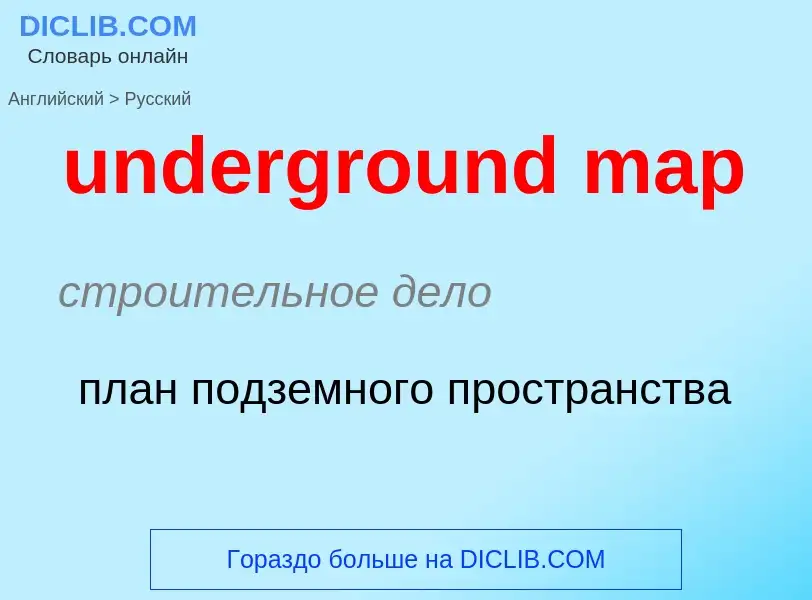Перевод и анализ слов искусственным интеллектом ChatGPT
На этой странице Вы можете получить подробный анализ слова или словосочетания, произведенный с помощью лучшей на сегодняшний день технологии искусственного интеллекта:
- как употребляется слово
- частота употребления
- используется оно чаще в устной или письменной речи
- варианты перевода слова
- примеры употребления (несколько фраз с переводом)
- этимология
underground map - перевод на русский
строительное дело
план подземного пространства
[ʌndəgraund'pres]
общая лексика
печать
выступающая против традиционных взглядов и норм (издания выходят небольшими тиражами)
модернистские
авангардистские издания для узкого круга
общая лексика
Linker Map
файл карты памяти
распределение памяти после компоновки
Map
ASCII-файл, используемый для онлайновых изображений карт в Web
общая лексика
физическая карта (генов в ДНК)
- consumption map
- cost map
- forecast map
- indifference map
- quality map
- resource map
- yield map
математика
диаграмма симметрии
Определение
Википедия
The Tube map (sometimes called the London Underground map or diagram) is a schematic transport map of the lines, stations and services of the London Underground, known colloquially as "the Tube", hence the map's name. The first schematic Tube map was designed by Harry Beck in 1931. Since then, it has been expanded to include more of London's public transport systems, including the Docklands Light Railway, London Overground, the Elizabeth line, Tramlink, the London Cable Car and Thameslink.
As a schematic diagram, it shows not the geographic locations but the relative positions of the stations, lines, the stations' connective relations and fare zones. The basic design concepts have been widely adopted for other such maps around the world and for maps of other sorts of transport networks and even conceptual schematics.
A regularly-updated version of the map is available from the official Transport for London website. In 2006, the Tube map was voted one of Britain's top 10 design icons which included Concorde, Mini, Supermarine Spitfire, K2 telephone box, World Wide Web and the AEC Routemaster bus. Since 2004, Art on the Underground has been commissioning artists to create covers for the pocket Tube map.

![[[Google Doodle]] in January 2013 (150th anniversary of the Tube) [[Google Doodle]] in January 2013 (150th anniversary of the Tube)](https://commons.wikimedia.org/wiki/Special:FilePath/Google Doodle London Underground Jan 2013.png?width=200)
![A [[London Buses]] "spider map" on display next to a Tube map at Waterloo Station A [[London Buses]] "spider map" on display next to a Tube map at Waterloo Station](https://commons.wikimedia.org/wiki/Special:FilePath/London bus tube spider maps.jpg?width=200)



![''[[East Village Other]]'' (April 16 – May 1, 1967) ''[[East Village Other]]'' (April 16 – May 1, 1967)](https://commons.wikimedia.org/wiki/Special:FilePath/EVOv2n1.jpg?width=200)
![''Fatigue Press'' was created by GIs at the [[Fort Hood]] U.S. Army base in Texas. ''Fatigue Press'' was created by GIs at the [[Fort Hood]] U.S. Army base in Texas.](https://commons.wikimedia.org/wiki/Special:FilePath/Fatigue Press Cover May1970.jpg?width=200)

![German-occupied Belgium]] during [[World War I]] German-occupied Belgium]] during [[World War I]]](https://commons.wikimedia.org/wiki/Special:FilePath/La Libre Belgique June 1915.jpg?width=200)
![Space City!]]'', April 1, 1971. Art by [[Bill Narum]]. Space City!]]'', April 1, 1971. Art by [[Bill Narum]].](https://commons.wikimedia.org/wiki/Special:FilePath/Narum SC lbj cover.jpg?width=200)
![Map of [[Utrecht]], Netherlands (1695). Map of [[Utrecht]], Netherlands (1695).](https://commons.wikimedia.org/wiki/Special:FilePath/Atlas de Wit 1698-pl044-Utrecht-KB PPN 145205088.jpg?width=200)
 (cropped).jpg?width=200)
![The ''[[Hereford Mappa Mundi]]'', [[Hereford Cathedral]], England, circa 1300, a classic "T-O" map with Jerusalem at the center, east toward the top, Europe the bottom left and Africa on the right The ''[[Hereford Mappa Mundi]]'', [[Hereford Cathedral]], England, circa 1300, a classic "T-O" map with Jerusalem at the center, east toward the top, Europe the bottom left and Africa on the right](https://commons.wikimedia.org/wiki/Special:FilePath/Hereford-Karte.jpg?width=200)
![In a [[topological map]], like this one showing inventory locations, the distances between locations are not important. Only the layout and connectivity between them matters. In a [[topological map]], like this one showing inventory locations, the distances between locations are not important. Only the layout and connectivity between them matters.](https://commons.wikimedia.org/wiki/Special:FilePath/Inventory Locations Represented as a Map.png?width=200)

![Relief map]] of the [[Sierra Nevada]] Relief map]] of the [[Sierra Nevada]]](https://commons.wikimedia.org/wiki/Special:FilePath/Maps-for-free Sierra Nevada.png?width=200)
![continental shelves]] and [[oceanic plateau]]s (red), the [[mid-ocean ridge]]s (yellow-green) and the [[abyssal plain]]s (blue to purple)}} continental shelves]] and [[oceanic plateau]]s (red), the [[mid-ocean ridge]]s (yellow-green) and the [[abyssal plain]]s (blue to purple)}}](https://commons.wikimedia.org/wiki/Special:FilePath/Mid-ocean ridge system.gif?width=200)
![Celestial map by the cartographer [[Frederik de Wit]], 17th century Celestial map by the cartographer [[Frederik de Wit]], 17th century](https://commons.wikimedia.org/wiki/Special:FilePath/Planisphæri cœleste.jpg?width=200)
![''[[Tabula Rogeriana]]'', one of the most advanced [[early world maps]], by [[Muhammad al-Idrisi]], 1154 ''[[Tabula Rogeriana]]'', one of the most advanced [[early world maps]], by [[Muhammad al-Idrisi]], 1154](https://commons.wikimedia.org/wiki/Special:FilePath/Tabula Rogeriana 1929 copy by Konrad Miller.jpg?width=200)

![USGS]] [[digital raster graphic]]. USGS]] [[digital raster graphic]].](https://commons.wikimedia.org/wiki/Special:FilePath/Topographic map example.png?width=200)
